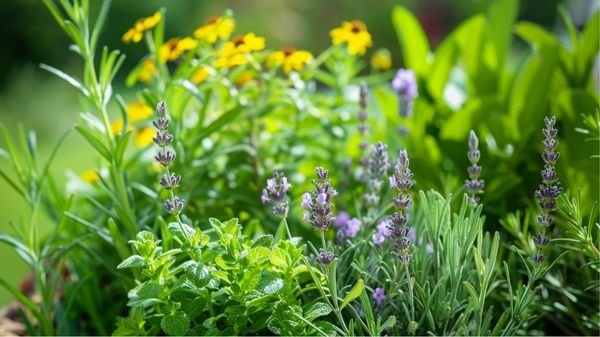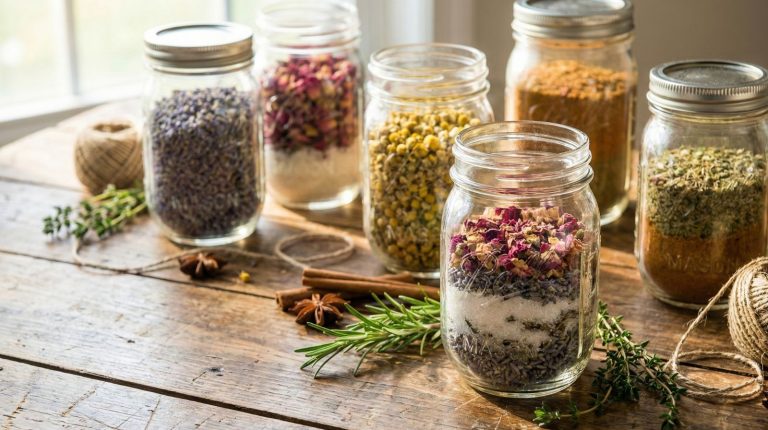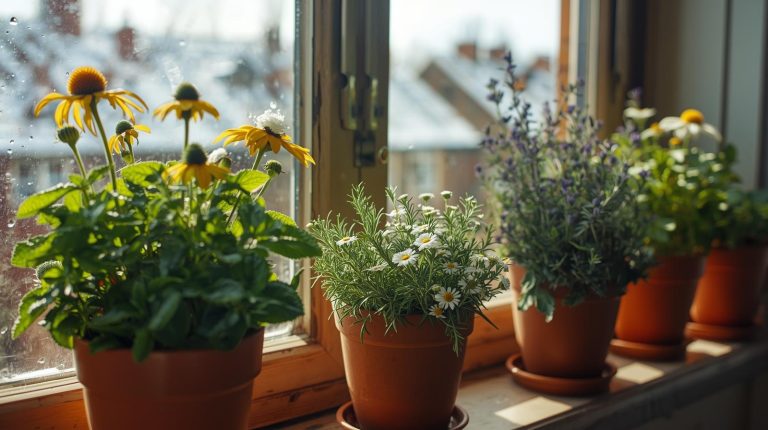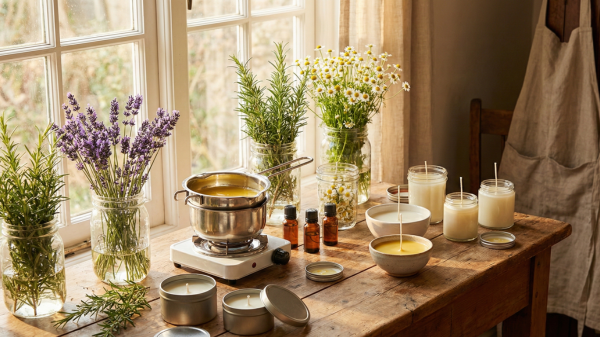To enhance your garden with medicinal plants, consider incorporating Echinacea for immune support, Chamomile for digestive health, and Lavender for its calming effects. Holy Basil offers antimicrobial properties, while Calendula aids in wound healing. Also, include Lemon Balm for stress reduction and Yarrow, renowned for its anti-inflammatory capabilities.
Dandelion contributes to liver health and nutrient density, and Peppermint provides digestive relief. Each of these plants possesses unique therapeutic attributes, consequently ensuring a multi-faceted approach to health. Understanding their specific benefits can help you maximize their potential and integrate them effectively into your wellness regimen. Further information is available.
Calendula Benefits
Calendula offers numerous health benefits that make it a valuable addition to your garden. With its impressive antibacterial and antifungal properties, this herb not only aids in wound healing but also prevents infections.
By cultivating calendula, you facilitate faster healing due to enhanced blood flow and oxygenation to damaged tissues, assisting in skin rejuvenation, particularly for abrasions, burns, and even diaper rash.
Additionally, calendula has shown potential in alleviating pain associated with anal tears, demonstrating its versatility in addressing various health issues. Furthermore, the presence of calendula in your garden can lead to improved overall wellness as it offers therapeutic benefits that contribute to a holistic approach to health.
To successfully engage in calendula cultivation, it’s vital to adhere to some straightforward calendula cultivation tips. Plant it in full sun and well-drained soil, allowing for best growth as an annual or perennial.
While integrating this beneficial plant into your garden, it’s important to keep in mind the calendula safety precautions. Although generally regarded as safe for topical applications, be aware that reactions can happen; performing a patch test before widespread use is advisable.
Additionally, limit the internal consumption of calendula due to insufficient scientific backing, especially for specific health claims.
Chamomile Healing Properties
For centuries, chamomile has been celebrated for its remarkable healing properties, making it a staple herb in gardens around the world. The numerous chamomile tea benefits are well-documented, as this comforting beverage can help soothe digestive issues such as nausea and heartburn, while also providing relief from cold symptoms and sore throats.
As you sip your tea, the anti-inflammatory and antibacterial properties work in harmony to bolster your immune system, promoting overall wellness. Chamomile is known to enhance sleep quality, making it an excellent choice for those struggling with insomnia.
Chamomile skin applications further showcase its versatility, offering effective treatment for a variety of conditions. With its soothing effects, chamomile can aid in healing minor cuts and burns and is particularly beneficial for skin inflammation, supporting those affected by conditions like eczema.
Incorporating chamomile into your skincare routine can enhance your regimen, whether through topical ointments containing chamomile or relaxing baths infused with chamomile flowers.
To maximize these benefits, you can prepare chamomile tea by steeping 2 to 3 heaping teaspoons of dried herb in one cup of boiling water for 10 to 15 minutes, and enjoy it three to four times daily, between meals, allowing its natural healing powers to ease your body and mind.
Lavender Uses in Wellness
Lavender, with its enchanting fragrance and diverse benefits, is a powerful ally in promoting wellness. You can seamlessly integrate lavender into your life through various means, effectively enhancing relaxation and self-care practices.
Primarily recognized for its calming properties, lavender improves sleep quality by utilizing aromatherapy, which helps you achieve a tranquil state and mitigate insomnia. Additionally, lavender boosts melatonin levels, further supporting restful nights.
Incorporating lavender relaxation techniques into your routine, like inhaling its essential oil or brewing lavender tea, offers substantial relief from anxiety and stress. Recent studies have shown that lavender also exhibits antimicrobial properties, making it beneficial for cleaning and wound healing.
Furthermore, lavender can be cultivated at home, providing easy access to this herbal medicinal plant for personal use and holistic remedies. Here are some ways to use lavender for your wellness:
- Elevate your lavender skincare routine by integrating topical lavender oil, which soothes skin irritations.
- Utilize lavender’s anti-inflammatory properties to ease menstrual pain and treat minor wounds.
- Experiment with inhalation methods to alleviate migraine headaches or muscle soreness naturally.
- Embrace lavender’s mood-lifting potential to support emotional balance and general well-being.
Holy Basil Attributes
Holy basil, often hailed as a sacred herb, carries a wealth of health benefits that make it a must-have for your garden. This remarkable plant boasts a variety of medicinal uses, contributing considerably to both physical and mental well-being.
Prominent among its attributes are its antimicrobial properties, which effectively address skin infections caused by bacteria and fungi, making it a valuable ally for treating conditions like acne and ringworm.
Moreover, holy basil acts as an expectorant, facilitating mucus expulsion during respiratory disorders, while also exhibiting antiviral effects that can expedite recovery from common colds.
When it comes to cardiovascular health, this herb demonstrates remarkable efficacy in normalizing blood sugar levels and lipid profiles, thereby protecting you from related diseases. In addition, it is recognized as a natural antibiotic, further supporting its role in promoting cardiovascular health.
Additionally, holy basil’s anti-inflammatory properties make it a potent remedy for conditions such as arthritis and skin irritations. As an immunomodulatory agent, it enhances your immune response and mitigates the impact of stress.
Integrating holy basil into your garden means embracing a natural approach to enhancing your overall health and well-being. Its versatile uses guarantee that this sacred herb truly deserves a place in your home.
Echinacea for Immunity
Echinacea is renowned for its immune system benefits, providing a natural boost that enhances your body’s ability to fight off infections. Rich in polysaccharides and flavonoids, this medicinal plant not only supports immune function but also offers significant antioxidant properties, protecting your cells from oxidative stress.
Integrating echinacea into your garden can yield a powerful ally in maintaining overall health and well-being, especially during cold and flu season. Preliminary studies suggest a potential role in inhibiting colon tumors with cichoric acid.
Immune System Benefits
Echinacea, renowned for its immune-boosting properties, offers a natural way to enhance your body’s defenses. The efficacy of Echinacea is particularly notable in its ability to stimulate immune cell activation, resulting in a robust immune response. By encouraging the production of various immune cells, including white blood cells and natural killer cells, Echinacea enhances your body’s capacity to fight infections.
- Boosts the production of immune cells, fortifying your defense mechanism.
- Activates macrophages, increasing their ability to destroy pathogens.
- Shows antiviral effects, potentially protecting against respiratory infections.
- Provides support for both innate and adaptive immunity, ensuring thorough protection.
Research indicates that Echinacea greatly contributes to the activation of lymphocytes, which are essential for adaptive immunity. Additionally, the two main species used for medicinal purposes, Echinacea purpurea and Echinacea angustifolia, highlight its significance in herbal remedies.
In addition, the enhanced cytokine production facilitated by Echinacea fosters better immune response coordination. Clinical trials support Echinacea’s potential to reduce the severity and duration of infections, particularly upper respiratory tract infections.
While some studies provide mixed results on Echinacea efficacy, its overall contribution to immune cell activation renders it a valuable addition to your garden for promoting health and well-being.
Antioxidant Properties
Many garden enthusiasts may not realize that Echinacea is a powerhouse of antioxidant properties, which play a crucial role in supporting overall health. The plant contains various compounds, such as phenols and alkamides, which contribute to its strong antioxidant profile.
This is fundamental for combating oxidative stress, as Echinacea preparations show effectiveness in scavenging harmful free radicals, thereby safeguarding your cells from damage.
When engaging in Echinacea cultivation, you’ll find that Echinacea purpurea is the most accessible species to grow. Basking in full sun enhances its flowering, yielding better medicinal yields.
For maximum antioxidant benefit, the roots are particularly potent, providing methanol extracts that demonstrate remarkable free radical scavenging capabilities. Additionally, Echinacea’s high antioxidant content makes it a popular choice for those looking to boost their immune system.
Utilizing Echinacea in your wellness routine can involve various preparations; you might choose fresh leaves, or create tinctures, extracts, or capsules. Incorporating these into your health regimen allows you to harness the plant’s antioxidant properties effectively.
Given its potential benefits in supporting immune function, fighting inflammation, and promoting overall well-being, Echinacea stands out as an important addition to your garden, whether for personal use or community-sharing.
Bergamot’s Therapeutic Effects
Bergamot has gained attention for its therapeutic effects, particularly in aiding digestion and promoting skin health.
When utilized for its antimicrobial properties, bergamot oil not only helps alleviate digestive discomfort but also supports wound healing and protects against minor skin infections. Moreover, bergamot is known for its ability to help lower overall cholesterol, contributing to improved cardiovascular health.
Digestive Aid Benefits
The digestive benefits of bergamot are becoming increasingly recognized for their therapeutic effects. Known for its ability to support digestive health, bergamot can alleviate a variety of gastrointestinal issues while also enhancing overall wellness. Its rich concentration of flavonoids and theaflavins actively work to combat inflammation and promote efficient digestion.
- Bergamot oil stimulates the secretion of digestive enzymes, improving digestion efficiency.
- Bergamot juice may inhibit inflammatory protein release, reducing diarrhea episodes associated with digestive disorders.
- The presence of theaflavins in bergamot tea can be instrumental in preventing stomach ulcers.
- Bergamot oil regulates peristaltic movement, allowing for smoother and quicker digestive processes.
Incorporating bergamot into your wellness routine provides several compelling bergamot benefits that directly relate to digestive health, including soothing indigestion and minimizing the discomfort associated with inflammatory conditions.
Additionally, the tea’s rich content of polyphenols may help reduce oxidative stress, further supporting digestive health. As you cultivate this medicinal herb, you’re not just growing a plant, but also nurturing a therapeutic ally for your digestive well-being.
Antimicrobial Properties
While exploring natural remedies for health, you might find bergamot standing out due to its impressive antimicrobial properties. Its peel extracts demonstrate significant efficacy against a range of pathogens, including Gram-negative bacteria like *Escherichia coli* and Gram-positive strains.
Importantly, this effectiveness increases with specific bergamot extraction methods, enhancing the activity of its pure flavonoids, such as neohesperidin, hesperetin, and naringenin. Recent studies indicate that enzymatic deglycosylation of flavonoids from bergamot can further enhance their antimicrobial activity.
As antimicrobial resistance solutions become increasingly crucial, bergamot offers a promising avenue. The oil’s antifungal capabilities are particularly remarkable, showing effectiveness against *Candida* species and dermatophytes, making it a potential candidate for topical treatments.
The antimicrobial profile of bergamot reveals not only its capacity to combat infections but also its potential integration into drug formulations aimed at addressing resistance issues.
Incorporating bergamot into your garden isn’t just about aesthetics—it’s about cultivating a resource that combines tradition with modern therapeutic applications.
With ongoing research into its mechanisms and potential as a natural antimicrobial agent, bergamot stands at the forefront of botanical innovation for health.
As you consider your garden, think of bergamot as an essential ally in your journey toward health and well-being.
Skin Healing Applications
With its remarkable therapeutic effects, bergamot oil stands out as a powerhouse for skin healing applications. Not only does it promote skin hydration, but it also plays an essential role in sebum regulation, ensuring your skin remains balanced regardless of type.
By stimulating skin cell regeneration, bergamot aids in the removal of scars and blemishes, effectively enhancing your skin’s overall appearance.
- Skin Balancing: Regulates sebum production, suitable for all skin types.
- Scar and Blemish Removal: Encourages cell regeneration to improve skin clarity.
- Anti-Inflammatory Effects: Reduces redness and inflammation linked to various skin conditions.
- Hydration: Retains moisture, combating dryness and flakiness.
To achieve the best results, always dilute bergamot oil with a carrier oil to mitigate potential irritation. Conducting a patch test is advisable to identify any sensitivities.
Due to its photosensitivity, avoid sun exposure after application. For targeted treatment, apply diluted oil directly to blemishes or inflamed areas.
Lemon Balm Advantages
Lemon balm offers a range of remarkable advantages that can boost both physical and mental health. This versatile herb is well-known for its digestive relief, potentially alleviating gastrointestinal discomfort and symptoms associated with indigestion.
Additionally, lemon balm exhibits antiviral and antimicrobial effects, making it useful against certain viral infections, including herpes simplex. Its ability to combat oxidative stress suggests it may help with cardiovascular and neurodegenerative conditions.
When it comes to mental health, lemon balm is recognized for its effectiveness in reducing stress and anxiety. It promotes calmness, facilitates improved mood, and may contribute beneficially to sleep patterns, especially when combined with valerian.
Moreover, you might find that lemon balm can enhance cognitive function and memory, particularly during periods of mental strain. Recent studies indicate that herbs like lemon balm can also support efforts in promoting biodiversity conservation, which is vital for preserving ecosystems and natural habitats.
However, when considering lemon balm cultivation, it’s important to keep lemon balm safety in mind. Potential side effects may include skin rashes and headaches, and caution should be exercised during pregnancy or while nursing.
Always consult a healthcare provider if incorporating it into your routine, particularly if you’re on medications or have existing health concerns.
Yarrow’s Healing Capabilities
When it comes to herbal remedies, yarrow stands out for its impressive healing capabilities. This versatile plant offers a multitude of yarrow applications that can support your health in various ways. Known for its anti-inflammatory and antiseptic yarrow properties, yarrow is an excellent choice for addressing numerous ailments.
- Yarrow aids in wound healing, effectively sealing cuts and reducing inflammation.
- Its calming influence can relieve menstrual cramps, providing comfort during difficult periods.
- The plant promotes digestive health, effectively addressing issues such as dyspepsia and loss of appetite.
- Its natural diaphoretic effects help reduce fever by encouraging sweating.
In both traditional and modern contexts, yarrow has been utilized extensively to alleviate respiratory concerns and support urinary health.
The chemical composition of yarrow, which includes beneficial volatile oils and salicylic acid, plays an essential role in its effectiveness, granting it properties that reduce pain and discomfort.
Utilizing sustainable practices in your gardening approach further enhances yarrow’s effectiveness while supporting its long-term availability.
When integrating yarrow into your health regimen, remember that its versatility makes it a valuable addition to your garden, enhancing your connection to nature while promoting well-being and community.
Dandelion Health Benefits
Dandelion greens offer a remarkable array of nutritional benefits, particularly in their high calcium, potassium, and vitamin A content, making them a valuable addition to your diet.
Historically, various cultures have harnessed their medicinal properties, addressing issues such as digestive health and liver detoxification.
As you explore the health benefits of dandelions, understanding both their nutritional value and traditional medicinal uses will empower you to maximize their potential in your wellness routine. Additionally, dandelion is recognized for its natural anti-inflammatory properties, which can contribute to joint health and wellness.
Nutritional Value Overview
Packed with a surprising array of nutrients, dandelion greens offer numerous health benefits that make them a valuable addition to your diet. Not only do they boast exceptional nutrient density, but their dietary impact can greatly support your overall health and wellness.
Consider these key nutritional highlights:
- Low in Calories: Just 24.7 calories per cup, making them a great option for light meals.
- Rich in Vitamins: Provides substantial amounts of Vitamin K (535% DV) and Vitamin A (112% DV) per serving.
- High in Fiber: Contains 1.9 grams of fiber per cup, exceeding the average for raw vegetables.
- Packed with Antioxidants: Loaded with compounds that combat oxidative stress and support cellular health.
Including dandelion greens in your meals can enhance nutrient intake while promoting essential health functions.
Their remarkable combination of vitamins, minerals, and antioxidants not only contributes to bone health but also supports weight management and digestive health.
As you integrate these greens into your diet, you’ll discover their powerful dietary impact, ultimately helping you reach your wellness goals.
Medicinal Uses Explained
Incorporating dandelion greens into your meals not only boosts your nutrient intake but also opens the door to a wealth of medicinal benefits.
When you consider dandelion extracts, you’re tapping into a powerful source for improving digestive health. For instance, dandelion root, rich in inulin, acts as a prebiotic fiber that alleviates constipation and promotes healthy digestion.
Dandelion greens contribute more than three grams of fiber per cooked cup, essential for maintaining bowel regularity and safeguarding against conditions like hemorrhoids.
Additionally, dandelion extracts possess notable anti-inflammatory properties, reducing markers of inflammation, which can be particularly beneficial for skin and liver health.
Traditional herbal remedies have long utilized dandelion for its liver-detoxifying abilities, and its prebiotic effects bolster your immune system by nurturing healthy gut bacteria.
From a cancer prevention perspective, studies indicate that dandelion root extract can suppress the growth of various cancer cell types.
Furthermore, its antimicrobial properties may offer protection against harmful bacteria and viruses. Consequently, cultivating dandelions in your garden equips you with both nutritional and medicinal resources that can enhance your well-being.
Peppermint’s Soothing Qualities
Since ancient times, peppermint has been revered for its soothing qualities, making it a staple in many gardens. This versatile plant offers numerous peppermint infusion benefits that can enhance your well-being.
In particular, the leaves can be brewed into a soothing tea, effectively alleviating digestive discomfort and relieving sinus issues. You’ll also find that peppermint essential oil is a powerful ally; when applied topically, it offers pain relief from headaches and muscle tension.
Consider utilizing peppermint for:
- Digestive support: Relieving stomach upset and improving gut health.
- Respiratory health: Easing congestion and promoting clearer airways.
- Pain relief: Managing headaches and muscle pain through direct application of essential oil.
- Morning sickness aid: Aiding nausea although it’s best to consult a healthcare provider if pregnant.
To maximize peppermint’s potential, cultivate it in sunny spots with moist soil, ensuring vibrant and active growth. Remember to harvest regularly to promote bushier plants.
While generally safe, approach peppermint oil therapy with caution, particularly if you have specific health concerns, such as gastrointestinal reflux or kidney stones.
Frequently Asked Questions
How Do I Grow These Medicinal Plants in My Home Garden?
To grow medicinal plants in your home garden, apply specific growing techniques tailored to each species.
Start by ensuring you have well-drained soil, as many plants thrive in these conditions. Implement proper spacing and sunlight requirements, applying gardening tips like regular watering and pruning.
Monitor for pests and diseases, and consider organic solutions for pest management. Finally, harvest at the correct times to maximize the plants’ medicinal properties, following seasonal guidelines effectively.
Are There Any Side Effects Associated With These Herbs?
Using herbal treatments can be like steering through a complex network, where herb safety and herbal interactions are essential to understand.
You might experience side effects such as allergic reactions from echinacea or increased bleeding risk with garlic, particularly when combined with blood thinners.
It’s important to consult healthcare providers about any herbal supplements to avoid dangerous interactions, and always prioritize high-quality products to mitigate potential risks associated with those treatments, ensuring your well-being remains intact.
Can These Plants Be Used in Cooking as Well?
Yes, these plants can certainly be used in cooking, providing both culinary uses and medicinal benefits.
For instance, herbs like mint and thyme enhance various dishes while offering unique flavor profiles and aiding digestion.
Rosemary’s robust taste complements meats and supports memory, while sage’s aromatic properties enhance soups.
Incorporating these herbs can elevate your culinary creations while also contributing positively to your health, exemplifying the synergy between gastronomy and herbal medicine.
How Should These Herbs Be Harvested for Best Results?
To guarantee ideal results when harvesting herbs, employ effective harvesting techniques: cut above leaf nodes with sharp tools, like scissors or clippers, to promote regrowth.
The best timing is in the morning after dew evaporates but before the sun’s heat intensifies. Avoid moisture to prevent decay during drying, and follow plant-specific guidelines for harvesting leaves, flowers, or roots, thereby maximizing potency and preserving quality for future use.
What Is the Best Time of Year to Plant Them?
When considering the best time of year to plant herbs, following a precise planting calendar is essential. Early spring offers prime conditions for annual and biennial herbs, while late spring or early summer is ideal for perennial varieties.
Use these seasonal tips to align your planting with local climatic conditions, ensuring that you maximize germination success. Additionally, indoor planting can be initiated from February to March, providing a continuous harvest year-round.
Conclusion
Cultivating medicinal plants in your garden not only enhances your green space but also provides a natural pharmacy at your fingertips. Each plant, from the vibrant calendula to the soothing peppermint, contributes unique benefits that can support your health and well-being.
By integrating these powerful botanicals into your daily life, you’re embracing holistic healing practices that harness nature’s gifts. So, nurture these herbal allies and watch them flourish, offering both beauty and medicinal virtues for years to come.




